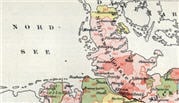Source Information
About Berlin, Germany, Marriages, 1874-1936
In the city of Berlin, 13 registry offices began work when the Prussian law from March 9, 1874, the "Gesetz über die Beurkundung des Personenstandes und die Form der Eheschließung," concerning the registration of civil status and marriage went into effect on October 1, 1874.
This collection includes the civil registers of marriages from 1874 to 1936.
The collection also contains the civil registers of marriage from cities and communities in the Teltow, Niederbarnim and Osthavelland rural districts in Brandenburg, which were later incorporated into greater Berlin starting October 1, 1920:
Adlershof, Altglienicke, Biesdorf, Blankenburg, Blankenfelde, Bohnsdorf, Boxhagen, Britz, Buch, (Französisch) Buchholz, Buckow, Charlottenburg, Dahme-Forst, Dahlem, Eiche, Falkenberg, Friedenau, Friedrichsfelde, Friedrichshagen, Frohnau, Grünau, Grunewald, Haselhorst, Heiligensee, Heinersdorf, Hellersdorf, Hermsdorf, Hohenschönhausen, Karlshorst, Karow, Kaulsdorf, Kladow, Köpenick, Johannisthal, Lankwitz, Lichtenberg, Lichtenrade, Lichterfelde, Lübars, Mahlsdorf, Malchow, Mariendorf, Marienfelde, Marzahn, Müggelheim, Niederschöneweide, Niederschönhausen, Nikolassee, Oberschöneweide, Pankow, Pfaueninsel, Pichelsdorf, Rahnsdorf, Reinickendorf, Rixdorf/Neukölln, Rosenthal, Rudow, Ruhleben, Rummelsburg, Schmöckwitz, Schöneberg, Schöneweide, Siemensstadt, Spandau, Staaken, Steglitz, Sternfeld, Tegel, Tempelhof, Treptow, Wannsee, Weißensee, Wilhelmsruh, Wilmersdorf, Wittenau, Zehlendorf.
Historical Background
Berlin's written records of civil registry documents demonstrate some unique, historically-based characteristics. The evacuation of registries in the final years of World War II and the administrative division of the city that took place in the post-war years, lead to fragmentation and proliferation of record keeping. In the western part of the city, copies were accordingly reclassified as originals because the originals were no longer available. New copies were created. At the same time, books from the western part of the city that were stored in the eastern part of the city were occasionally still maintained and supplemented. According to the civil status laws which applied in the GDR; however, the duplicates of the civil registers and collected files were no longer maintained there and were, to a great extent, destroyed as prescribed. In the beginning of the 1990s, the books returned to the originally responsible offices, so now both reclassified and restored original registers can be found there. It was not possible to align and supplement the margin notes before the new "Personenstandsgesetz" (civil status law) went into effect in 2009.
Accordingly duplicates of the civil registers also appear within this collection if entries were found to deviate from the original register.
For inquiries and further research, please contact the Landesarchiv Berlin (Berlin State Archive) directly [email protected]
Record Details
Registration was recorded on pre-printed forms, bound into books. Each volume begins with entry no. 1. The entries then continue regularly throughout the calendar year and end with a closing remark from the registrar.
Registration of Marriages
The registration of a marriage takes place directly in front of the registrar, which means that the date on the certificate is the same as the date of the marriage. The civil ceremony is legally binding. Additionally, a church wedding could also take place – on the same day or at a later time – which was then entered into the church register.
Occasionally, notice of intended marriage was given, but the marriage did not take place. This is why there may be entries that are crossed out in the marriage register; if the registrar had already filled out the form, but the engaged couple did not show up.
The form consists of two pages.
You can find the following information in the marriage entries:
- Place of issue (often identical to the registry office)
- Issue date of the certificate
- Certificate number
- Name, marital status, religion, occupation, date of birth, place of birth, address of the bride
- Possibly also: Name of the previous marital partner
- Name, marital status, religion, occupation, date of birth, place of birth, address of the groom
- Name, occupation, address, parents of the groom
- Name, occupation, address, parents of the bride
- Possibly also: Parents' date of death
- Name, occupation, address of both witnesses to the marriage
- Date of marriage (same as the date of issue of the certificate)
 Need help with the German language?
Need help with the German language?